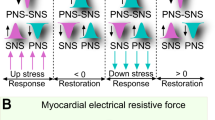Abstract
The heart is a typical nonlinear oscillator. In mammals the heartbeat is controlled by the heart’s own pacemaker, called the sinoatrial node (SAN), which emits electrical pulses, that trigger the contraction of the heart muscle. The isolated SAN is a periodic oscillator1, but in the intact heart the node is controlled by the autonomic nervous system. Para-sympathetic nerves reduce the rate and sympathetic nerves increase the rate at which the SAN’ fires’ its electrical pulses. The two types of nerves are therefore in a constant’ fight’ to control the electrical activity of the SAN resulting in substantial fluctuations in the time intervals (RR-intervals) between successive heartbeats in healthy subjects. Recent studies of these fluctuations in RR-intervals as well as of whole electrocardiograms using nonlinear methods have indicated that the dynamics of the heart is chaotic2-4. On the other hand it has been known for more than a decade that certain heart dysfunctions and severe diabetes can be associated with a loss in the variability of the RR-intervals5, 6, suggesting that during these illnesses the heartbeat becomes more regular and hence’ less’ chaotic. In this study we employ nonlinear forecasting to analyze the RR-intervals of electro-cardiograms from 120 patients who have experienced their first myocardial infarction, and 35 normal subjects. The purpose of this study was to evaluate if nonlinear forecasting could be used to characterize the dynamics of the heart and in particular if this method would reveal any differences between the normal subjects and the patients.
Access this chapter
Tax calculation will be finalised at checkout
Purchases are for personal use only
Preview
Unable to display preview. Download preview PDF.
Similar content being viewed by others
References
A. Noma, Mechanisms underlying cessation of rabbit sinoatrial node pacemaker activity in high potassium solutions, Jap. J. Physiol. 26:619 (1976).
A. Babloyantz and A. Destexhe, Is the normal heart a periodic oscillator, Biol. Cybern. 58:203 (1988).
M. Courtemanche, L. Glass, J. Belair, D. Scagliotti and D. Gordon, A circle map in the human heart, Physica 40D:299 (1989).
F. Ravelli and R. Antolini, Complex dynamics underlying the human electrocardiogram, Biol. Cybern. 67:57 (1992).
R.E. Kleiger, J.P. Miller, J.T. Bigger, A.J. Moss and the Multicenter Post-Infarction Research Group, Decreased heart rate variability and its association with increased mortality after acute myocardial infarction, Am. J. Cardiol. 59:256 (1987).
D.J. Ewing, J.M.M. Neilson, C.M. Shapiro, J.A. Stewart and W. Reid, Twenty four hour heart rate variability: effects of posture, sleep, and time of day in healthy controls and comparison with bedside tests of autonomic function in diabetic patients, Br. Heart J. 65:239 (1991).
D. Ruelle, Sensitive dependence on initial conditions and turbulent behavior in dynamical systems, Ann. N.Y. Acad. Sci. 316:408(1979).
J.D. Farmer and J.J. Sidorowich, Predicting chaotic time series, Phys. Rev. Lett. 59:845 (1987).
G. Sugihara and R.M. May, Nonlinear forecasting as a way of distinguishing chaos from measurement error in time series, Nature 344:734 (1990).
F. Takens, Detecting strange attractors in turbulence, Lect. Notes Math. 898:366 (1981).
D.T. Kaplan, M.I. Funnan, S.M. Pincus, S.M. Ryan, L.A. Lipsitz and A.L. Goldberger, Aging and the complexity of cardiovascular dynamics, Biophys. J. 59:945 (1991).
Author information
Authors and Affiliations
Editor information
Editors and Affiliations
Rights and permissions
Copyright information
© 1993 Springer Science+Business Media New York
About this chapter
Cite this chapter
Jørgensen, B.L., Junker, A., Mickley, H., Møller, M., Christiansen, E., Olsen, L.F. (1993). Nonlinear Forecasting of RR-Intervals of Human Electrocardiograms. In: Christiansen, P.L., Eilbeck, J.C., Parmentier, R.D. (eds) Future Directions of Nonlinear Dynamics in Physical and Biological Systems. NATO ASI Series, vol 312. Springer, Boston, MA. https://doi.org/10.1007/978-1-4899-1609-9_84
Download citation
DOI: https://doi.org/10.1007/978-1-4899-1609-9_84
Publisher Name: Springer, Boston, MA
Print ISBN: 978-1-4899-1611-2
Online ISBN: 978-1-4899-1609-9
eBook Packages: Springer Book Archive




